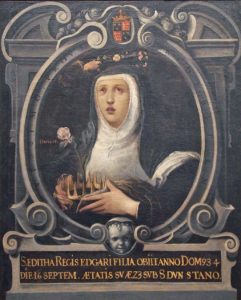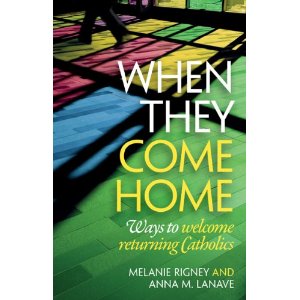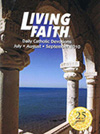The Basics: Born about 961 in England; died September 16, 984, in England; canonized pre-congregation; feast day, September 16; woman religious.
The Story: She lived inside the walls of Wilton Abbey nearly all her life, but Edith’s twenty-three years still intrigue us. Her father, King  Edgar, carried off her mother, Wulfrida, from the abbey under circumstances that are less than clear. Wulfrida returned with Edith after a year, but reportedly was on good terms with Edgar, who later offered to set up Edith in three different abbeys (Edith refused each time). Some say she also was asked to become queen after a half-brother died, but refused that as well.
Edgar, carried off her mother, Wulfrida, from the abbey under circumstances that are less than clear. Wulfrida returned with Edith after a year, but reportedly was on good terms with Edgar, who later offered to set up Edith in three different abbeys (Edith refused each time). Some say she also was asked to become queen after a half-brother died, but refused that as well.
Edith was, we might say, a less than traditional nun, even after her mother became the Wilton abbess. Edith kept a zoo of wild and domesticated animals next to the abbey. She liked to paint, and was known as a woman who dressed well, even as a nun. She was quick with a retort when she was criticized for her finery.
The story of Edith’s life as the sisters in her community saw it was recorded by a monk named Goscelin, and is still available today. There also are a number of stories about related miracles after her death.
Edith’s Wisdom: “For pride may exist under the garb of wretchedness; and a mind may be as pure under these vestments as under your tattered furs.”
What We Can Learn from Edith: When we listen to God and surrender to His plans, we will have the wisdom to discern whether tempting offers are His will, and the faith to say no when they are not.
To Learn More About Edith: Read the abstract for a translation of Goscelin’s Writing the Wilton Women.
To Learn More About Other Women Saints and Blesseds: Come back next week, or consider buying my book, Sisterhood of Saints: Daily Guidance and Inspiration.



{ 2 comments… read them below or add one }
The case of the tenth-century saint Edith of Wilton illustrates the way collaboration, patronage and public relations worked in a medieval context. Watt devotes a chapter to the account of Edith’s life and posthumous miracles by the Flemish monk Goscelin of St Bertin. Goscelin was an émigré intellectual who arrived in England around 1060. He worked as a tutor, chaplain and writer for hire, composing saints’ lives for a number of monasteries in the aftermath of the Norman Conquest. He was commissioned to write the Life of Edith by Godgifu, the abbess of Wilton Abbey in Wiltshire. In his prologue, Goscelin explains that Godgifu and the other nuns told him about the events of Edith’s life, which were part of the community’s recent memory. Anticipating the objection that his sources were women and therefore not to be believed, Goscelin argued that the noble birth and sacred lives of these nuns gave them credibility.
Edith was a charismatic figure, at times too lively for the monastic life. She was the daughter of King Edgar and a woman he had abducted from Wilton Abbey. Three years later, Wulfthryth returned with her infant daughter. Edith received a splendid education at Wilton, where she was admired for her singing, reading, writing and exquisite embroidery. Goscelin remarks that in his time the monastery still held a book of spiritual devotions in Edith’s hand. As the daughter of a king, she was also a potential power player. When she was only fifteen, Edgar placed her at the head of three monastic houses, though she appointed other women to govern them while she remained at Wilton. Goscelin also relates the crisis three years after Edgar’s death, when his successor, Edward the Martyr, was killed. The nobility, Goscelin says, believed Edward’s half-brother, Æthelred, was tainted by the murder, and offered the throne to Edith, who refused it. Scholars have doubted this story, or suggested that the plan was to marry her to a rival successor. But Goscelin, writing for female patrons about a woman saint, wanted to make it known that she had turned down the offer of ultimate authority. The English considered a woman with ‘mature prudence’ a better leader than an ignorant child, he claims, adding that many nations are governed by women.
Though young – she died at 23 – Edith embodied ‘auctoritas’ in the full sense that word carried in the Middle Ages. She was powerful, exemplary, wise, and capable of expressing her designs on the world. Her legacy, as Watt notes, included a chapel she had built at Wilton, dedicated to Saint Denis and containing a series of paintings she commissioned from an artist called Benno. Goscelin’s account of their collaboration is a useful description of the way female patronage and authorship worked. Benno ‘brought out the images that she depicted in her heart’; he was the bee divining the intentions of Edith, the flower. Benno was the artist, but there was no doubt about who was the chapel’s author. Edith is also shown bringing stones to the construction site, feeding and cheering up the workmen, and encouraging them with promises of rewards. As patron, she was labourer, helpmeet and project manager. Goscelin didn’t say so, but his own employer, Godgifu, probably played a similar role.
Goscelin’s treatment of Edith’s idiosyncrasies reveals the balance he tried to strike between historical memory and the wishes of the Wilton community. Edith kept a menagerie of wild animals in a courtyard attached to the monastery. Goscelin compared her fondness for these exotic pets to God’s love for the beasts of his creation. Edith’s regal habits seem to have come under scrutiny from her contemporaries, but Goscelin usually found a way to turn the story round. Bishop Æthelwold criticised her for her extravagant way of dressing, which he thought inappropriate for a spiritual life. Edith told the bishop he should not judge people’s souls by external appearances. To prove the point, Goscelin related a miracle story in which a servant accidentally set a chest full of Edith’s clothes on fire. The flames spread throughout the room, but when the sisters opened the chest they found Edith’s finery unharmed. God apparently had no issue with the future saint’s sense of style.
Edith’s story, and that of the women who promoted her cult in the century after her death, shows the value of Watt’s undertaking. Shining a light on medieval women’s writing brings their other kinds of authority into focus. These highly educated individuals capably navigated secular and ecclesiastical networks of power both in England and abroad. They taught, guided and managed, sometimes while also dealing with political upheavals or missionary work. They leveraged their social and financial capital to build enduring legacies. The works they wrote and had written reflected their beliefs: that what a nun wore was no guide to the purity of her soul, or that a young woman might make an excellent ruler for a troubled nation if only she could be persuaded to take on the task. (“The Flower and the Bee” Irina Dumitrescu, London Review of Books, April, 2021 )
Thanks for this! All the saints have such fascinating stories.